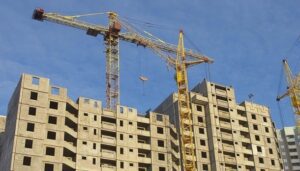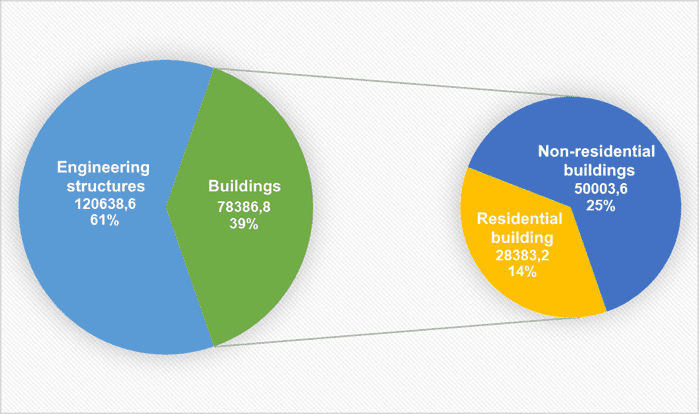
The Austrian HEAD Group has begun construction of a plant for the production of equipment for winter sports on the territory of the industrial park Winter Sport in Vinnytsia, the start of which was postponed a year ago due to the COVID-19 pandemic, the website of Vinnytsia City Council said.
At the same time, it is specified that the commissioning of the new plant, which will be one of the largest plants of the HEAD Group, is scheduled for 2023, it is planned to create at least 1,200 jobs.
As reported, the total investment in the project is EUR 80 million, the area of production facilities for the production of skis, ski boots and bindings is 43,000 square meters.
The total area of the industrial park Winter Sport, where the enterprise will be built, is 25 hectares.

The volume of construction work performed in Ukraine in January-March 2021 decreased by 12.8% compared to the same period in 2020. According to the State Statistics Service, in January-March, the volume of construction work performed amounted to UAH 26.3 billion. In March 2021 the seasonally adjusted index of construction products amounted to 99.7% compared to the previous month, the one adjusted for the effect of calendar days compared to March 2020 was 90.4%.
The service reported that in March 2021 from March 2020, an increase in the volume of construction work was observed in the segment of residential construction – by 8.6%, engineering structures – by 9.7%. At the same time, in non-residential construction, the decline in the volume of construction work amounted to 4.2%.
The share of new construction in the total volume of completed construction work amounted to 44.5%, repairs – 27.9%, reconstruction and technical re-equipment – 27.6%.
An increase in the volume of construction work in January-March 2021 compared to January-March 2020 was recorded in Khmelnytsky (by 40.8%), Rivne (by 29.2%), Ternopil (by 9.2%) and Kharkiv (by 4.7%) regions.
In other regions, there was a decrease in construction volumes. The most significant drop was shown by Chernivtsi (by 59.4%) and Vinnytsia (by 56%) regions.
As reported, the volume of construction work performed in Ukraine in 2020 increased by 4% compared to 2019.

President of Ukraine Volodymyr Zelensky has said that he welcomes the signing of an intergovernmental agreement between Ukraine and Turkey on housing construction for Crimean Tatars, which will allow the construction of about 500 residential apartments, including for internally displaced persons.
“I welcome the signing of an intergovernmental agreement between Ukraine and Turkey on cooperation in the field of housing construction. This makes it possible to build about 500 apartments for representatives of the Crimean Tatar people and other internally displaced persons. This is a very important humanitarian project that will bring the peoples of Ukraine and Turkey closer together,” Zelensky said at the ceremony of signing Ukrainian-Turkish documents with Turkish President Recep Tayyip Erdogan.
In addition, according to Zelensky, “further liberalization of trade and economic relations between Ukraine and Turkey is important.”
“The signing of a bilateral free trade area agreement will be able to significantly increase the momentum of cooperation,” Zelensky said.
“This is a very important step that must be taken in accordance with the national interests of each of the countries, because we agreed with the President of Turkey that the relevant institutions of our countries will conduct a very substantive audit of all controversial issues and find a mutual compromise that will open the way to signing of this important document,” the president added.
The presidents also discussed the prospects for Turkish investments in Ukraine, in particular “opportunities for large-scale privatization in the field of investments in seaports, as well as cooperation in the energy and military spheres, including aircraft construction.”
“Our goal is the implementation of specific projects, the creation of joint ventures, the exchange of experience and technologies,” the President of Ukraine said.
Volume of construction products produced by type in 2020 (mln uah)


The cost of construction of business class facilities over the past five years has increased by more than 30-40%, in 2021 it may grow by another 10-20%, Head of the Sales Department of A 136 Highlight Tower Olena Polesko told Interfax-Ukraine.
“The trends of the last two years indicate the interest of a potential buyer in high quality construction with the use of new technological engineering solutions. Special attention is also paid to the architecture of the building, future comfort level and infrastructure in the residential complex under construction,” Olena Polesko said.
According to the expert, the location remains one of the main conditions for the construction of business class complexes, therefore, the central part of the city is usually chosen for such purposes.
“The demand for high-quality business class facilities annually increases by an average of 7-10%. In addition, every year in Kyiv there are less and less free plots for construction in the central part of the city. Hence the systematic growth in the cost of business class apartments,” the expert said.
According to her data, from 2015 to 2020, the cost of apartments in business class residential complexes increased by more than 50%.
According to Polesko, for objects belonging to the business class category, a closed adjoining territory (for example, a green lounge area with outdoor fireplaces and soft sofas), the presence of its own parking lot with electric chargers, infrastructure on the ground floors, the presence of office premises with a separate entrance, round the clock video surveillance, security service, a spacious lobby with the ability to hold business meetings, as well as round the clock concierge service are considered compulsory.
“The status of the facility obliges developers to create new functional services and opportunities, such as, for example, smartbox – a separate space for sports equipment, Lovelypaw – a room for caring for pets, a room for a children’s area with professional babysitting services, a fitness area, or even Fashion hub – a service for residents of such complexes, the essence of which is the ability to order new items from the best designers’ boutiques in Kyiv and use fitting rooms on the territory of a residential complex,” the expert said.
As for technological innovations, building of the business class are increasingly equipped with general house water filtration, individual ventilation units with air purification from harmful gases, unpleasant odors and allergens, for example, pet hair or fine dust.
According to the expert, in 2021, due to the lack of new sites, the supply of business class apartments in the central part of the capital may decrease by 15-20%.
“Due to the reduction in supply, the growth in the cost of housing in modern high-quality business class facilities in 2021 may be from 10% to 20%, depending on the quality of construction, and the conditions created for the comfort of future buyers,” the expert said.

Delta Ukraine, part of the Austrian company Delta Holding, has begun construction of the headquarters of the German company Zeppelin in Vyshneve, Kyiv region.
According to the press service of Delta Ukraine, the facility will include an office part, a training center for its own mechanics and customers’ equipment operators, workshops for the repair of equipment and components, spare parts warehouses, areas for storage and demonstration of equipment and a customs-licensed warehouse.
“Work on the project began back in 2017. Then, through the joint efforts of Delta Ukraine and Delta Wels, a concept was developed and a budget was calculated in two months,” the company said.
Delta Ukraine is part of the Austrian company Delta Holding, founded in 1977 in Wels. It provides services for construction, design, construction management, general contracting, and green building certification. The company has subsidiaries in Austria, the Czech Republic, Slovakia and Ukraine.
Zeppelin GmbH is a German industrial concern, represented in 20 countries around the world in the field of dealership and production, the official exclusive dealer of U.S. Cat equipment in Ukraine.